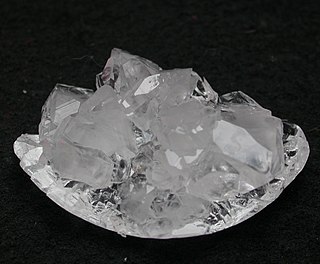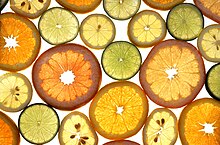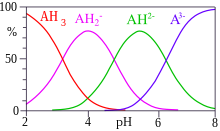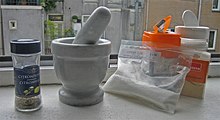Citric acid
| |||

| |||
| Names | |||
|---|---|---|---|
| IUPAC name
Citric acid[1]
| |||
| Preferred IUPAC name
2-Hydroxypropane-1,2,3-tricarboxylic acid[1] | |||
| Identifiers | |||
3D model (
JSmol ) |
|||
| ChEBI | |||
| ChEMBL | |||
| ChemSpider | |||
| DrugBank | |||
ECHA InfoCard
|
100.000.973 | ||
| EC Number |
| ||
| E number | E330 (antioxidants, ...) | ||
IUPHAR/BPS |
|||
| KEGG | |||
PubChem CID
|
|||
RTECS number
|
| ||
| UNII | |||
CompTox Dashboard (EPA)
|
|||
| |||
| |||
| Properties | |||
| HOC(CO2H)(CH2CO2H)2 | |||
| Molar mass | 192.123 g/mol (anhydrous), 210.14 g/mol (monohydrate)[2] | ||
| Appearance | white solid | ||
| Odor | Odorless | ||
| Density | 1.665 g/cm3 (anhydrous) 1.542 g/cm3 (18 °C, monohydrate) | ||
| Melting point | 156 °C (313 °F; 429 K) | ||
| Boiling point | 310 °C (590 °F; 583 K) decomposes from 175 °C[3] | ||
| 54% w/w (10 °C) 59.2% w/w (20 °C) 64.3% w/w (30 °C) 68.6% w/w (40 °C) 70.9% w/w (50 °C) 73.5% w/w (60 °C) 76.2% w/w (70 °C) 78.8% w/w (80 °C) 81.4% w/w (90 °C) 84% w/w (100 °C)[4] | |||
| Solubility | Soluble in acetone, alcohol, ether, ethyl acetate, DMSO Insoluble in C 6H 6, CHCl3, CS2, toluene[3] | ||
| Solubility in ethanol | 62 g/100 g (25 °C)[3] | ||
| Solubility in amyl acetate | 4.41 g/100 g (25 °C)[3] | ||
| Solubility in diethyl ether | 1.05 g/100 g (25 °C)[3] | ||
1,4-dioxane
|
35.9 g/100 g (25 °C)[3] | ||
| log P | −1.64 | ||
| Acidity (pKa) | pKa1 = 3.13[5] pKa2 = 4.76[5] pKa3 = 6.39,[6] 6.40[7] pKa4 = 14.4[8] | ||
Refractive index (nD)
|
1.493–1.509 (20 °C)[4] 1.46 (150 °C)[3] | ||
| Viscosity | 6.5 cP (50% aq. sol.)[4] | ||
| Structure | |||
| Monoclinic | |||
| Thermochemistry | |||
Heat capacity (C)
|
226.51 J/(mol·K) (26.85 °C)[9] | ||
Std molar
entropy (S⦵298) |
252.1 J/(mol·K)[9] | ||
Std enthalpy of (ΔfH⦵298)formation |
−1543.8 kJ/mol[4] | ||
| 1985.3 kJ/mol (474.5 kcal/mol, 2.47 kcal/g),[4] 1960.6 kJ/mol[9] 1972.34 kJ/mol (471.4 kcal/mol, 2.24 kcal/g) (monohydrate)[4] | |||
| Pharmacology | |||
| A09AB04 (WHO) | |||
| Hazards | |||
| Occupational safety and health (OHS/OSH): | |||
Main hazards
|
Skin and eye irritant | ||
| GHS labelling: | |||
  [5] [5]
| |||
| Warning | |||
| H290, H319, H315[5] | |||
| P305+P351+P338[5] | |||
| NFPA 704 (fire diamond) | |||
| Flash point | 155 °C (311 °F; 428 K) | ||
| 345 °C (653 °F; 618 K) | |||
Explosive limits
|
8%[5] | ||
| Lethal dose or concentration (LD, LC): | |||
LD50 (median dose)
|
3000 mg/kg (rats, oral) | ||
| Safety data sheet (SDS) | HMDB | ||
Except where otherwise noted, data are given for materials in their standard state (at 25 °C [77 °F], 100 kPa).
| |||
Citric acid is an
More than two million tons of citric acid
A citrate is a derivative of citric acid; that is, the
6H
5O3−
7 or C
3H
5O(COO)3−
3.
Natural occurrence and industrial production

Citric acid occurs in a variety of fruits and vegetables, most notably
Citric acid was first isolated in 1784 by the chemist Carl Wilhelm Scheele, who crystallized it from lemon juice.[13][14]
Industrial-scale citric acid production first began in 1890 based on the Italian
In 1917, American food chemist James Currie discovered that certain strains of the mold Aspergillus niger could be efficient citric acid producers,[17] and the pharmaceutical company Pfizer began industrial-level production using this technique two years later, followed by Citrique Belge in 1929. In this production technique, which is still the major industrial route to citric acid used today, cultures of Aspergillus niger are fed on a sucrose or glucose-containing medium to produce citric acid. The source of sugar is corn steep liquor, molasses, hydrolyzed corn starch, or other inexpensive, carbohydrate solution.[18] After the mold is filtered out of the resulting suspension, citric acid is isolated by precipitating it with calcium hydroxide to yield calcium citrate salt, from which citric acid is regenerated by treatment with sulfuric acid, as in the direct extraction from citrus fruit juice.
In 1977, a patent was granted to
Global production was in excess of 2,000,000 tons in 2018.[20] More than 50% of this volume was produced in China. More than 50% was used as an acidity regulator in beverages, some 20% in other food applications, 20% for detergent applications, and 10% for applications other than food, such as cosmetics, pharmaceuticals, and in the chemical industry.[15]
Chemical characteristics

Citric acid can be obtained as an anhydrous (water-free) form or as a monohydrate. The anhydrous form crystallizes from hot water, while the monohydrate forms when citric acid is crystallized from cold water. The monohydrate can be converted to the anhydrous form at about 78 °C. Citric acid also dissolves in absolute (anhydrous) ethanol (76 parts of citric acid per 100 parts of ethanol) at 15 °C. It decomposes with loss of carbon dioxide above about 175 °C.
Citric acid is a tribasic acid, with pKa values, extrapolated to zero ionic strength, of 3.128, 4.761, and 6.396 at 25 °C.[21] The pKa of the hydroxyl group has been found, by means of 13C NMR spectroscopy, to be 14.4.[22] The speciation diagram shows that solutions of citric acid are buffer solutions between about pH 2 and pH 8. In biological systems around pH 7, the two species present are the citrate ion and mono-hydrogen citrate ion. The SSC 20X hybridization buffer is an example in common use.[23][24] Tables compiled for biochemical studies are available.[25]
Conversely, the pH of a 1 mM solution of citric acid will be about 3.2. The pH of fruit juices from
Acid salts of citric acid can be prepared by careful adjustment of the pH before crystallizing the compound. See, for example, sodium citrate.
The citrate ion forms complexes with metallic cations. The
Citric acid can be esterified at one or more of its three carboxylic acid groups to form any of a variety of mono-, di-, tri-, and mixed esters.[27]
Biochemistry
Citric acid cycle
Citrate is an intermediate in the
Some bacteria (notably
Other biological roles
Citrate can be transported out of the
High concentrations of cytosolic citrate can inhibit phosphofructokinase, the catalyst of a rate-limiting step of glycolysis. This effect is advantageous: high concentrations of citrate indicate that there is a large supply of biosynthetic precursor molecules, so there is no need for phosphofructokinase to continue to send molecules of its substrate, fructose 6-phosphate, into glycolysis. Citrate acts by augmenting the inhibitory effect of high concentrations of ATP, another sign that there is no need to carry out glycolysis.[30]
Citrate is a vital component of bone, helping to regulate the size of apatite crystals.[31]
Applications
Food and drink

Because it is one of the stronger edible acids, the dominant use of citric acid is as a flavoring and preservative in food and beverages, especially soft drinks and candies.
Citric acid can be added to ice cream as an emulsifying agent to keep fats from separating, to caramel to prevent sucrose crystallization, or in recipes in place of fresh lemon juice. Citric acid is used with sodium bicarbonate in a wide range of effervescent formulae, both for ingestion (e.g., powders and tablets) and for personal care (e.g., bath salts, bath bombs, and cleaning of grease). Citric acid sold in a dry powdered form is commonly sold in markets and groceries as "sour salt", due to its physical resemblance to table salt. It has use in culinary applications, as an alternative to vinegar or lemon juice, where a pure acid is needed. Citric acid can be used in food coloring to balance the pH level of a normally basic dye.[citation needed]
Cleaning and chelating agent

Citric acid is an excellent
In industry, it is used to dissolve rust from steel, and to passivate stainless steels.[37]
Cosmetics, pharmaceuticals, dietary supplements, and foods
Citric acid is used as an acidulant in creams, gels, and liquids. Used in foods and dietary supplements, it may be classified as a processing aid if it was added for a technical or functional effect (e.g. acidulent, chelator, viscosifier, etc.). If it is still present in insignificant amounts, and the technical or functional effect is no longer present, it may be exempt from labeling <21 CFR §101.100(c)>.
Citric acid is an
Citric acid is commonly used as a buffer to increase the solubility of brown heroin.[39]
Citric acid is used as one of the active ingredients in the production of facial tissues with antiviral properties.[40]
Other uses
The
Citric acid is used as an odorless alternative to
Sodium citrate is a component of Benedict's reagent, used for both qualitative and quantitative identification of reducing sugars.[41]
Citric acid can be used as an alternative to nitric acid in passivation of stainless steel.[42]
Citric acid can be used as a lower-odor stop bath as part of the process for developing photographic film. Photographic developers are alkaline, so a mild acid is used to neutralize and stop their action quickly, but commonly used acetic acid leaves a strong vinegar odor in the darkroom.[43]
Citric acid/potassium-sodium citrate can be used as a blood acid regulator. The citric acid is included to improve palatability[44]
Citric acid is an excellent soldering flux,[45] either dry or as a concentrated solution in water. It should be removed after soldering, especially with fine wires, as it is mildly corrosive. It dissolves and rinses quickly in hot water.
Alkali citrate can be used as an inhibitor of kidney stones by increasing urine citrate levels, useful for prevention of calcium stones, and increasing urine pH, useful for preventing uric acid and cystine stones.[46]
Synthesis of other organic compounds
Citric acid is a versatile precursor to many other organic compounds. Dehydration routes give itaconic acid and its anhydride.[47] Citraconic acid can be produced via thermal isomerization of itaconic acid anhydride.[48] The required itaconic acid anhydride is obtained by dry distillation of citric acid. Aconitic acid can be synthesized by dehydration of citric acid using sulfuric acid:[49]
- (HO2CCH2)2C(OH)CO2H → HO2CCH=C(CO2H)CH2CO2H + H2O
Acetonedicarboxylic acid can also be prepared by decarboxylation of citric acid in fuming sulfuric acid.[50]
Safety
Although a weak acid, exposure to pure citric acid can cause adverse effects. Inhalation may cause cough, shortness of breath, or sore throat. Over-ingestion may cause abdominal pain and sore throat. Exposure of concentrated solutions to skin and eyes can cause redness and pain.[51] Long-term or repeated consumption may cause erosion of tooth enamel.[51][52][53]
Compendial status
See also
- The closely related acids isocitric acid, aconitic acid, and propane-1,2,3-tricarboxylic acid (tricarballylic acid, carballylic acid)
- Acids in wine
Explanatory notes
- ^ This still does not make the lemon particularly strongly acidic. This is because, as a weak acid, most of the acid molecules are not dissociated so not contributing to acidity inside the lemon or its juice.
References
- ^ ISBN 978-0-85404-182-4.
- ^ CID 22230 from PubChem
- ^ a b c d e f g "citric acid". chemister.ru. Archived from the original on November 29, 2014. Retrieved June 1, 2014.
- ^ a b c d e f CID 311 from PubChem
- ^ a b c d e f Fisher Scientific, Citric acid. Retrieved on 2014-06-02.
- ^ "Data for Biochemical Research". ZirChrom Separations, Inc. Retrieved January 11, 2012.
- ^ "Ionization Constants of Organic Acids". Michigan State University. Retrieved January 11, 2012.
- ISSN 0966-0844.
- ^ a b c Citric acid in Linstrom, Peter J.; Mallard, William G. (eds.); NIST Chemistry WebBook, NIST Standard Reference Database Number 69, National Institute of Standards and Technology, Gaithersburg (MD) (retrieved 2014-06-02)
- ^ a b c "Citric acid | C6H8O7 - PubChem". Archived from the original on January 19, 2022. Retrieved December 19, 2021.
- ISBN 978-3-319-11232-9.
- PMID 18290732.
- ^ Scheele, Carl Wilhelm (1784). "Anmärkning om Citron-saft, samt sätt at crystallisera densamma" [Note about lemon juice, as well as ways to crystallize it]. Kungliga Vetenskaps Academiens Nya Handlingar [New Proceedings of the Royal Academy of Science]. 2nd series (in Swedish). 5: 105–109.
- ^ Graham, Thomas (1842). Elements of chemistry, including the applications of the science in the arts. Hippolyte Baillière, foreign bookseller to the Royal College of Surgeons, and to the Royal Society, 219, Regent Street. p. 944. Retrieved June 4, 2010.
- ^ ISBN 978-3527306732.
- ISBN 978-0-7923-0625-2.
- ^ Currie, James (1917). The Journal of Biological Chemistry. American Society for Biochemistry and Molecular Biology. pp. 15–27.
- PMID 17317159.
- ^ US 4056567-V.Lamberti and E.Gutierrez
- ^ "Global Citric Acid Markets Report, 2011-2018 & 2019-2024". prnewswire.com. March 19, 2019. Retrieved October 28, 2019.
- S2CID 94614267.
- S2CID 11615864.
- ^ "SSC - OpenWetWare".
- ^ Maniatis, T.; Fritsch, E. F.; Sambrook, J. 1982. Molecular Cloning: A Laboratory Manual. Cold Spring Harbor Laboratory, Cold Spring Harbor, NY.
- ISBN 9780121818012.
- .
- .
- ^ Powell, Alvin (February 14, 2014). "59,000 generations of bacteria, plus freezer, yield startling results". phys.org. Retrieved April 13, 2017.
- PMID 18524956.
- ISBN 978-0716746843.
- PMID 21127269.
- ISBN 9789251049495.
- .
- ISSN 0009-2347.
- S2CID 219432688.
- ^ "ASTM A967 / A967M - 17 Standard Specification for Chemical Passivation Treatments for Stainless Steel Parts". www.astm.org.
- PMID 29642579.
- S2CID 8516420.
- ^ "Tissues that fight germs". CNN. July 14, 2004. Retrieved May 8, 2008.
- PMID 23932089.
- ^ "Pickling and Passivating Stainless Steel" (PDF). Euro-inox.org. Archived from the original (PDF) on September 12, 2012. Retrieved 2013-01-01.
- ^ Anchell, Steve. "The Darkroom Cookbook: 3rd Edition (Paperback)". Focal Press. Retrieved January 1, 2013.
- ^ PubChem. "Sodium citrate". pubchem.ncbi.nlm.nih.gov. Retrieved August 2, 2021.
- ^ "An Investigation of the Chemistry of Citric Acid in Military Soldering Applications" (PDF). June 19, 1995. Archived (PDF) from the original on March 15, 2020.
- PMID 1507355.
- .
- .
- .
- .
- ^ NIOSH. September 18, 2018. Archived from the originalon July 12, 2018. Retrieved September 9, 2017.
- .
- ^ "Effect of Citric Acid on Tooth Enamel".
- ^ British Pharmacopoeia Commission Secretariat (2009). "Index, BP 2009" (PDF). Archived from the original (PDF) on April 11, 2009. Retrieved February 4, 2010.
- ^ "Japanese Pharmacopoeia, Fifteenth Edition" (PDF). 2006. Archived from the original (PDF) on July 22, 2011. Retrieved 4 February 2010.



